
transcript of the PASSPORT TO KNOWLEDGE program
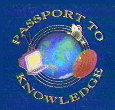
#101, "THE GREAT PLANET DEBATE"
first aired November 9, 1995, over public television and NASA-TV

transcript of the PASSPORT TO KNOWLEDGE program

Underwriter acknowledgment: student announcer (female):
Live from Hubble Space Telescope is made possible in part by the National
Aeronautics and Space Administration, the National Science Foundation,
PBS K-12 Learning Services and public television.
Narrator (Dr. WILLIAM A. GUTSCH) over NASA and STScI footage and
animations of the HST and its discoveries:
| November, 1995: the Hubble Space Telescope reveals astonishing close-up images of star forming regions in M-16, the Eagle Nebula, some seven thousand light years from Earth -- amazingly detailed images that show organic-looking columns of gas, light years long, sculpted by the pressure of light and particles from nearby stars. |  |
In the years since its launch in 1990, the Hubble has looked much further out into our still mysterious universe, peering deep into galaxies and the black holes which seem to power some of them, painting a portrait of dark space dotted with myriad shapes, the abode perhaps of other astronomically-inclined beings who survey the universe with their own space telescopes.
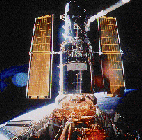 | But Hubble itself has also
looked much closer to home, revealing a
colder, drier Mars than that seen by the last spacecraft to come this
way, twenty years ago. Hubble also tracked the impact of mountain-sized
chunks of comet Shoemaker-Levy 9 on Jupiter and surveyed the results of
this once -in-a-thousand lifetimes' cosmic collision. Hampered at first by a misshapen mirror, a highly successful Servicing Mission in 1993 replaced one camera and inserted corrective lenses that restored much of Hubble's promised eyesight. This demonstrated that further improvements can be expected from new instruments to be installed in 1997 and on into the next century. This remarkable telescope, a cooperative venture of America's NASA and the European Space Agency has helped rewrite the book on our cosmos near and far, delivering block-buster images from orbit nearly every week. |
|
GUTSCH, on camera, in the lobby of STScI: This is a model of the Hubble Space Telescope here at the Space Telescope Science Institute in Baltimore. The real space telescope is five times larger and orbits the globe every couple of hours more than three hundred miles above our heads. Now I have a question for you. How would you like to be able to use the real space telescope to observe objects across the universe? Well, believe it or not, this coming March this largest telescope ever put into space is going to be as close to you as your television screen or your computer modem. Students like you from across the country and around the world will be able to work with top research scientists at deciding which of several objects in space we are going to be studying next March with this very special telescope. This program is going to tell you how to participate in this exciting and totally unique experiment in science education and outreach. And outreach is a good word because, via the Internet, you are going to be able to reach out to this unique research tool. | 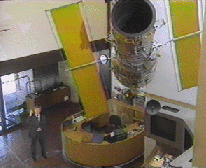
|
closeup:
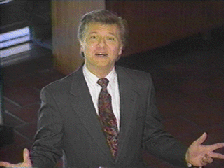 |
Student announcer:
Passport to Knowledge presents Live from the Hubble Space Telescope.
TITLE SEQUENCE
Narrator (Dr. GUTSCH) over NASA and STScI footage and animations of
the HST and its discoveries:
The Hubble Space Telescope is an amazingly complex observatory,
forty-three feet long, the size of a school bus, and weighing over
twenty-five thousand pounds. Every few hours it orbits the Earth, passing
from dark night into the heat of sunlight. Packed deep down inside the
telescope's insulated shell is its ninety-four-and-a-half inch primary
mirror, which allows scientists to see things ten times clearer than the
telescopes on the surface of the Earth. A secondary mirror bounces light
from distant objects down into an area the size of a dinner plate, where
an array of cameras and other detectors wait. In outer space, the Hubble
can catch ultraviolet radiation, and sometimes infrared, blocked by the
Earth's turbulent water-laden atmosphere. An array of filters can select
different colors in different kinds of light, giving Hubble great
flexibility in the types of observations it can do.
Hubble signals bounce from orbit via Tracking and Data Relay Satellites down to NASA's Goddard Space Flight Center in Greenbelt, Maryland, which controls the spacecraft itself, and finally on to the Space Telescope Science Institute on the campus of Johns Hopkins University in Baltimore, which is responsible for all scientific aspects of Hubble's missions.
GUTSCH on camera:
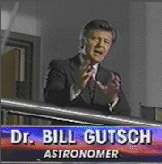 | By now I think you can see
how unique and exciting a research tool the
Hubble Space Telescope is for doing cutting-edge astronomy. In fact, for
every five astronomers who want to get time on the Hubble Space Telescope
there's only enough time to give one of those a chance to actually use
it. (editor's note: the current ratio is more like 10:1, which makes our
project all the more astonishing!) But this Spring, NASA and the Space
Telescope Science Institute are giving us and you three complete orbits
of the Hubble Space Telescope with which to do some exciting new
research. And they are giving us all of the facilities, the scientists,
the computers, that they normally give the top researchers around the
world. Now here is where you come in. Together, we have to choose which of four planets the Hubble Space Telescope is going to observe next Spring. We picked planets for several reasons: one, they are rather bright objects, and that means that we can do some real science in only a couple of orbits of the Hubble Space Telescope, and secondly because planets usually have some rather interesting details on their surfaces or in their atmospheres. |
Here at Passport to Knowledge we have also enlisted the services of four top research planetary astronomers, we'll call them our "Planetary advocates", who are going to work with you at trying to figure out and trying to determine which one of the four planets we are going to be studying.
The Planet Advocates are seen: GUTSCH continues voice over: In alphabetical order, our Planet Advocates are:
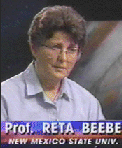 | 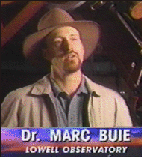 | 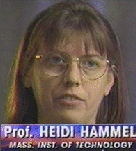 | 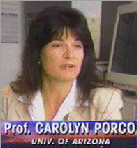 |
| Dr. Reta Beebe, from New Mexico State University, who will help us study the planet Jupiter. | For Pluto, Dr. Marc Buie, from the Lowell observatory in Flagstaff, Arizona. | For the planet Neptune, we have Dr. Heidi Hammel, from the Massachusetts Institute of Technology... | And for Uranus, Dr. Carolyn Porco from the University of Arizona. |
Our thanks to all of them for their commitment to this exciting project. In many ways, you students will be the co-investigators on this research project with these scientists, and this program will show you how to participate.
Closing Underwriter announcement:
Live from the Hubble Space Telescope is made possible in part
by the National Aeronautics and Space Administration, the National
Science Foundation, PBS K-12 Learning Services and Public Television.
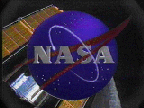 |  |  |

![]()